|
|
|
|
| Special Topics #16 |
Phacelia distans and Phacelia tanacetifolia
|
This page is the result of my desire
to find out what the Phacelia species around the Eaton Canyon Visitor
Center area are. Some years ago I was told they were mostly tanacetifolia,
but having seen that taxon several times in other places I had serious
doubts about that identification. In the Jepson Manual, it says: And Abrams' Illustrated Flora
of the Pacific States adds: The first set of pictures are from the first sample I looked at. These four samples are from Eaton Canyon. The stamens appear to be long-exserted, which would make it tanacetifolia according to the floral keys, but distans stamens are typically exserted also, just not quite as much. However the calyx lobes are definitely not linear to lance-linear, which rules against tanacetifolia. The fruit seems to be somewhat ovoid but also hairy below the middle, which gives mixed results. I will say that on all samples I looked at, the flowers had gone from the lower part of the inflorescence, and this would fit the "corollas deciduous" description for distans. Unfortunately, all three of the sources specifically mention the unequal calyx lobes for distans, but none of them mentions whether this is true for tanacetifolia, which is quite irritating. Clearly, these pictures do show unequal calyx lobes, but this doesn't rule out tanacetifolia. I measured the pedicels on this sample at between 1 and 2 mm, which would be another character in favor of distans. I should say that these were all collected in the same general area. I began this investigation without knowing for sure which taxon these samples represent. It is my understanding that botanists have for a long time had difficulty separating these two species, and they are so similar in so many of their characteristics that I initially suspected that they should not even be considered as separate species. Further investigation will follow. |
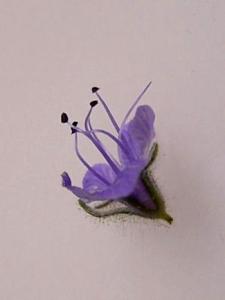 |
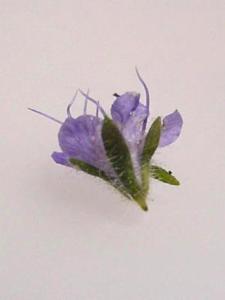 |
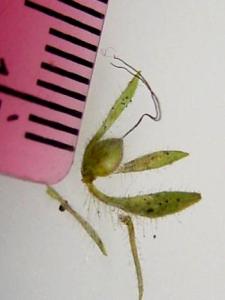 |
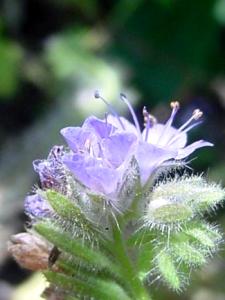 |
 |
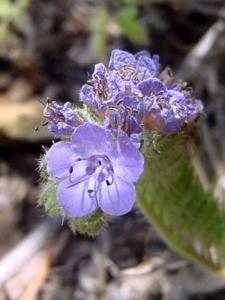 |
| This second set of pictures is from the second sample I took. Again the stamens appear to be clearly exserted, but the fruits are much more spheric yet mostly hairy in the upper half. Again, the calyx lobes appear unequal with some being almost linear and others being oblanceolate or obovate. I measured pedicels on this sample fairly uniformly at about 1 mm. In fact I don't think any of my samples had pedicels that were clearly less than 1 mm. Most calyx lobes were about 1 to 1.5 mm wide. |
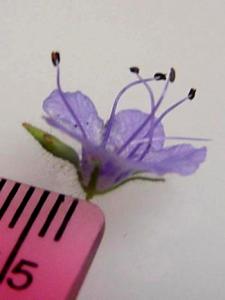 |
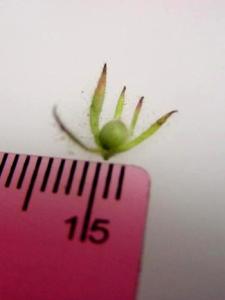 |
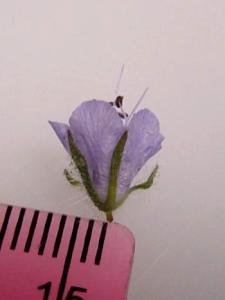 |
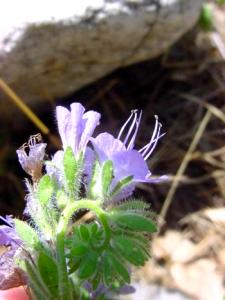 |
 |
| This is the third set of sample pictures from the third sample I collected. Exserted stamens, spheric fruit, pedicels 1 mm. Most of the calyx lobes were about 1 mm wide, a few 1.5 mm. It's difficult to say whether the fruits are hairy only above the middle or also below the middle. Sometimes one fruit seems to have hair mainly in the upper half, but others on the same sample have hairs below the middle. At this point I can't find anything obviously differentiating any of these three samples. If they are all the same, then the fruit shapes do vary and the amount of hairiness on the fruits varies, and the length of the pedicel varies, but in no consistent way. |
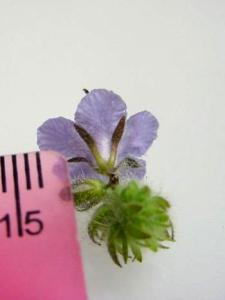 |
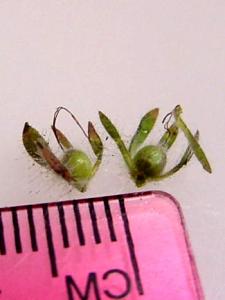 |
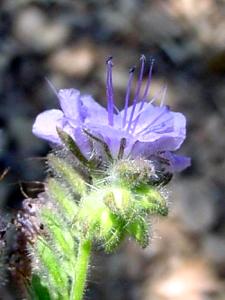 |
| This was the last sample, next to the parking lot, and again there is nothing consistently obvious about it that makes it different from any of the other samples. Pedicels were about 1 mm, the fruits were almost spheric, mostly hairy in the upper half but with a few straggling short hairs below the middle. I measured calyx lobe lengths and pretty consistently got 6 mm for all samples with a few measurements of 7 mm. If all of these samples are tanacetifolia, then why are the calyx lobes, especially the wider ones, not linear or lance-linear, and why are some of the fruits so clearly globose? If all of these samples are distans, why are the stamens long-exserted? If some are one and some are the other, what is it that consistently differentiates them? To quote Tom Chester, "I'm confused." What I need is a definite tanacetifolia and a definite distans to compare to these samples. The problem is reflected in the fact that many of the Phacelia distans and Phacelia tanacetifolia vouchers at Rancho Santa Ana were originally classified as the OTHER taxon, so just finding a definite individual of one or the other is extremely difficult. |
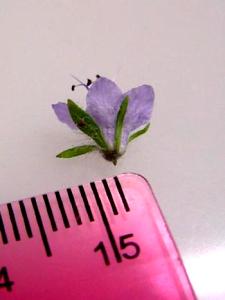 |
| With his permission
I am incorporating into this page some notes contributed by Tom Chester
re- garding his observations of vouchers of these two taxa at Rancho Santa Ana Botanic Garden, and he wishes it to be known that "these were tentative conclusions, arrived at only by quickly looking at a single folder each of each species, with maybe 20 specimens in each folder. i.e., the conclusions were not the result of careful detailed study, since we only had 10 minutes before the herbarium closed. the folders were for a specific area, but i didn't write down which one." 1. Fruit is nearly impossible to look at without dissecting the vouchers, which is very time-consuming. 2. "Corolla deciduous" seems to be true for perhaps 5/6 of the P. distans vouchers, but 1/6 have corolla persistent. 3. "Corolla persistent" seems to be true for perhaps 5/6 of the P. tanacetifolia vouchers, but 1/6 have corolla deciduous. 4. It is EXTREMELY HARD to measure pedicel lengths in vouchers, due to the crowdedness of the flowers. kay and i were really only able to see the pedicel length of the very lowermost fruit, and that only for some vouchers. 5. P. distans did seem to have pedicels longer than 1 mm in fr, when the pedicels could be observed. 6. P. tanacetifolia did seem to have pedicels <~ 1 mm in fr, when the pedicels could be observed. 7. I found NO OTHER READILY-DISCERNIBLE CHARACTERISTICS to separate the species. the leaves varied tremendously in shape and fineness of the divisions for both species, with the same range for both. 8. As near as i could tell from glancing at the specimens, i couldn't see any difference in how exserted the stamens were between the species. but didn't study this closely; I didn't have time. it was hard to even see the stamens in most of the samples at a glance. 9. Using the two fairly clear traits of pedicels in fruit and corollas deciduous, two of the three vouchers of "P.t." for SD County split evenly, one characteristic going to P.d. and one characteristic going to P.t. (:-( the calyx lobe length for these went to P.d., making the score 2-1 p.d., yet these vouchers were id'd as P.t. by Lauri, who just did the flora of Palomar Mountain. (but we didn't study the calyx lobe length in the vouchers.) There were a few fruit on one of these specimens; they measured to be 2.5-2.7 mm, within the overlap between these species. (:-( The third voucher, the one quoted in the 2006 SD County checklist, had no fruit, and can't really be determined. (:-( 10. a significant number of the vouchers in the P.d. and P.t. folders had originally been classified as the OTHER species. Clearly, most botanists are confused about these species. |
| Here are several pictures of the Phacelia from the Palm Canyon area in Anza Borrego which have been more or less definitely identified as P. distans by Tom Chester. They show definitely exserted stamens but not really the long-exserted ones of tanacetifolia. Distans stamens can be twice the length of the corolla with tanacetifolia stamens being longer. They also show calyx lobes that are definitely not linear or lance-linear. If the calyx lobe shape as outlined in the floras is a valid discriminant, then all the samples from Eaton Canyon would be distans. |
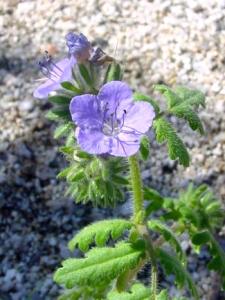 |
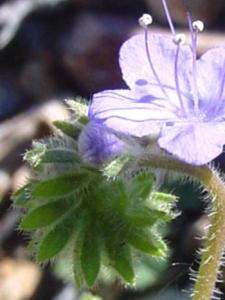 |
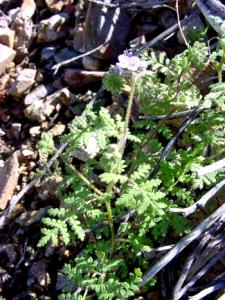 |
| And here are three pictures of what I believe to be tanacetifolia from different locations showing the much longer-exserted stamens, and also showing what appear to be much narrower and more linear calyx lobes. The third picture also may illuminate what is meant by "corollas persistent" with many more flowers blooming on the inflorescence at the same time than is usual for P. distans. Looking at these pictures, along with the fairly certain P. distans pictures from Anza-Borrego, as well as the fairly certain P. distans which I studied today near Hahamongna Watershed Park that are essentially the same as the Eaton Canyon individuals, I am now leaning toward the assumption that all the Eaton Canyon plants are P. distans. And now my question, "If all of these samples are distans, why are the stamens long-exserted?" can be answered by saying that they are not long-exserted, merely exserted. |
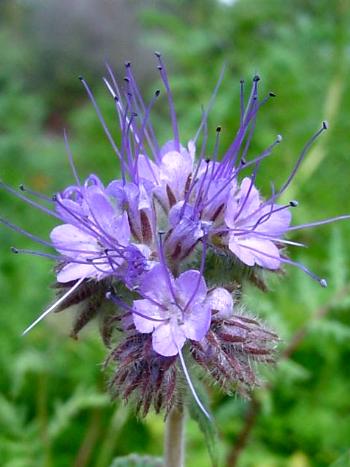 |
 |
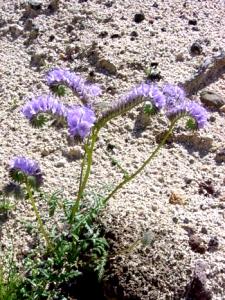 |
| I have not said anything about the shape of the leaves, but my memory of them is that tanacetifolia has leaves that are in appearance often more feathery with the individual leaflets being narrower and more linear than in distans, and with a greater amount of space between the individual pairs of leaflets, that is with a more generally open look to the leaf. The variation in shape is quite large in both species, with an area of overlap where the leaves look quite similar. And the leaves also change shape in outline and in the number and shape of the leaflets as the leaves age, so a young leaf looks quite different from a mature leaf. In general I think the margins of leaflets in distans in more ragged than in tanacetifolia due to serrations in the lobes of the leaflets. The lobes of tanacetifolia leaflets seem to be more smooth and rounded. The following three pictures are I believe Phacelia distans leaves. |
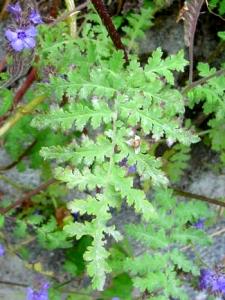 |
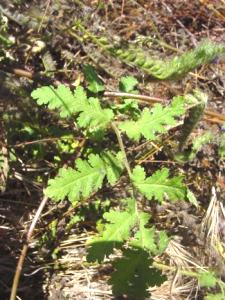 |
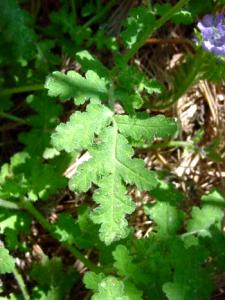 |
| And here are some Phacelia tanacetifolia leaves. |
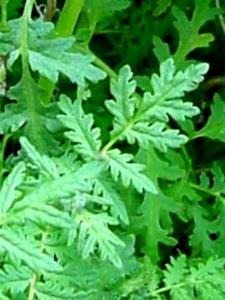 |
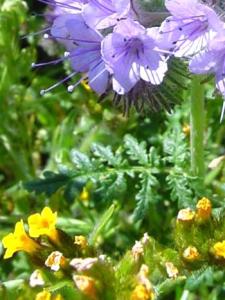 |
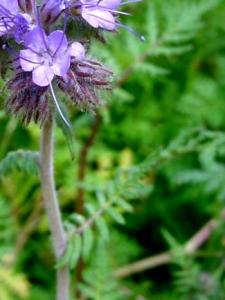 |
| Looking back now at the key discriminants referred to at the beginning, and assuming that all the Eaton Canyon samples are in fact P. distans, almost all of what is said about that taxon is correct, with the following exception: the calyx lobes should be recorded as 4-7 mm. Since I don't have samples of tanacetifolia to study, I can't verify the pedicel length, the calyx lobe length or the relative glabrousness of the fruits. If I can collect some samples, I will try to add those observations at a later time. Finally, here's a set of four pictures, P. distans on the left, P. tanacetifolia on the right. Look especially at the length of the stamens and the shape of the calyx lobes. |
 |
 |
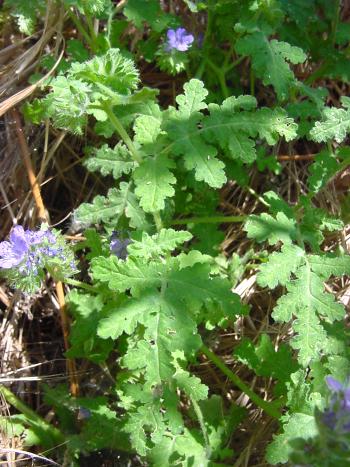 |
 |
| Comments and/or questions should be directed to: mmlcharters@calflora.net. |